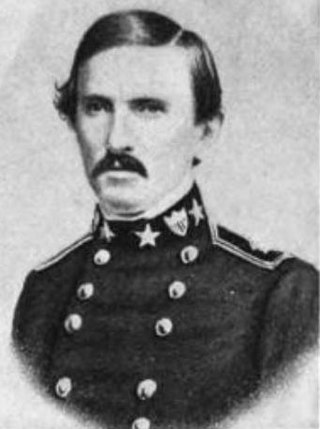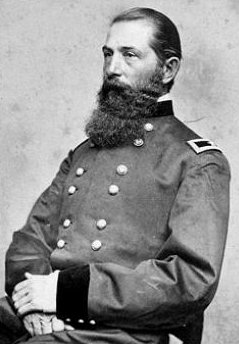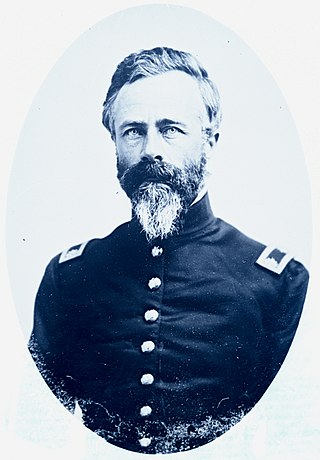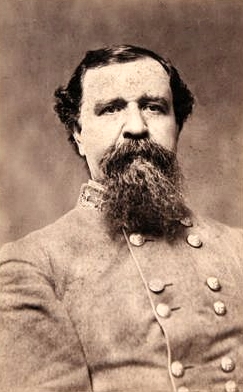
Thomas Leonidas Crittenden was an American statesman, politician, soldier and lawyer from the U.S. state of Kentucky. He served as a general for the Union during the Civil War. His family was fairly typical for Kentucky, in that he and his father supported the Union during the war, but his elder brother fought for the Confederacy.

George Bibb Crittenden was a career United States Army officer who served in the Black Hawk War, the Army of the Republic of Texas, and the Mexican–American War, and later resigned his commission to serve as a general in the Confederate States Army in the American Civil War.

The Battle of Baton Rouge was a ground and naval battle in the American Civil War fought in East Baton Rouge Parish, Louisiana, on August 5, 1862. The Union victory halted Confederate attempts to recapture the capital city of Louisiana.

Louis Hébert was an American educator, civil engineer, writer and soldier who became a brigadier general in the Confederate States Army during the American Civil War.
The 16th Wisconsin Infantry Regiment was a volunteer infantry regiment that served in the Union Army during the American Civil War. For much of the war, the regiment was commanded by Cassius Fairchild, the brother of Wisconsin's 10th governor Lucius Fairchild.

David Allen Russell was a career United States Army officer who served in the Mexican–American War and the American Civil War. He was killed in action as a brigadier general in the Union Army.

Simon Goodell Griffin was a Union Army brigadier general during the American Civil War, farmer, teacher, lawyer and New Hampshire state legislator.

Hiram Bronson Granbury was a lawyer and county judge in Texas before the American Civil War. He organized a volunteer company for the Confederate States Army after the outbreak of the Civil War and became its captain. He rose to the grade of brigadier general in the Confederate army. Granbury was one of the six Confederate generals killed at the Battle of Franklin on November 30, 1864.

John Horace Forney was a farmer, civil engineer, and major general in the Confederate States Army during the American Civil War. Being promoted to the rank of major general on October 27, 1862, Forney participated in the Battles of First Bull Run and Vicksburg before being captured. He held several other commands until the end of the Civil War, living in Alabama until his death in 1902.

Thomas R. Williams was an antebellum United States Army officer and a brigadier general in the Union Army during the Civil War. He was killed as he commanded the Union troops at the Battle of Baton Rouge.
The 7th Kentucky Infantry Regiment was an infantry regiment that served in the Union Army during the American Civil War.
The 19th Kentucky Infantry Regiment was an infantry regiment that served in the Union Army during the American Civil War.
The 22nd Kentucky Infantry Regiment was an infantry regiment that served in the Union Army during the American Civil War.
The 3rd Kentucky Infantry Regiment was a volunteer infantry regiment that served in the Confederate States Army during the American Civil War. It was part of the First Kentucky Brigade through August 1862.
The 7th Kentucky Infantry Regiment was an infantry regiment that served in the Confederate States Army during the American Civil War.
The 42nd Ohio Infantry Regiment was an infantry regiment in the Union Army during the American Civil War.
The 1st Missouri Infantry was an infantry regiment that served in the Confederate States Army during the American Civil War. Originally commanded by Colonel John S. Bowen, the regiment fought at the Battle of Shiloh, where it was engaged near the Peach Orchard on April 6, 1862. On April 7, during the Union counterattacks at Shiloh, the regiment was instrumental in preventing the Washington Artillery from being captured. The regiment was next engaged at the Second Battle of Corinth, where it outflanked several Union positions. On the second day at Corinth, the regiment was only minimally engaged. On November 7, the 1st Missouri Infantry was combined with the 4th Missouri Infantry to form the 1st and 4th Missouri Infantry (Consolidated), as a result of heavy battle losses in both regiments.

Thomas Hart Taylor was a Confederate States Army colonel, brigade commander, provost marshal and last Confederate post commander at Mobile, Alabama, during the American Civil War. His appointment as a brigadier general was refused by the Confederate Senate after Confederate President Jefferson Davis failed to nominate Taylor, apparently following Davis's appointment of Taylor to the rank. Nonetheless, Taylor's name is frequently found on lists and in sketches of Confederate generals. He was often referred to as a general both during the Civil War and the years following it. Before the Civil War, Taylor served as a first lieutenant in the 3rd Kentucky Volunteer Infantry Regiment during the Mexican–American War. After that war, he was a cattle driver, farmer and lawyer. After the Civil War, he was engaged in business in Mobile, Alabama for five years, and after returning to Kentucky, was a Deputy U.S. Marshal for five years and was chief of police at Louisville, Kentucky, for eleven years.

Louis Douglas Watkins was a soldier in the Union Army during the American Civil War.











